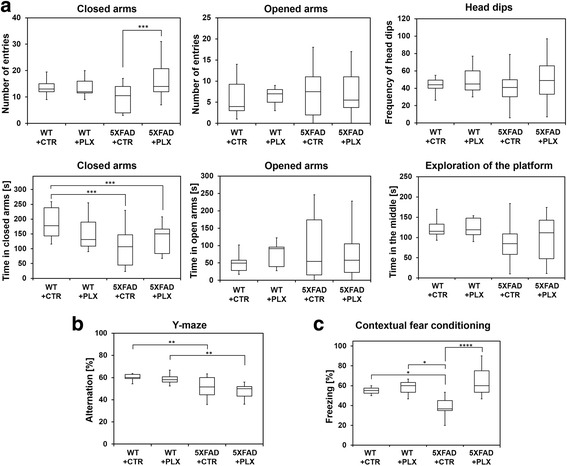Fig. 4.

PLX3397 treatment improves behavioral phenotype. Contextual fear conditioning (a), Y-maze (b) and elevated plus maze (c) tests were performed. a In the contextual fear conditioning test, 5XFAD mice show significantly lower levels of contextual freezing than wild-type controls (p < 0.02, denoted by *). However, treatment with PLX3397 significantly reversed the impaired fear behavior to the level of a normal reconsolidation of the contextual fear memory (p < 0.00008 with Tukey correction test, denoted by ****). b The total number of arm entries was significantly changed in the group of 5XFAD mice regardless the treatment (p < 0.005 with Tukey correction test, denoted by **), indicating lower levels of motor and exploratory activity in the group of AD mice. c In the elevated plus maze test, although the number of entries into closed arms was increased in the 5XFAD mice treated with PLX3397 (p < 0.001 denoted by ***), the number of entries into opened arms was not significantly different among all four groups. Neither another behavioral parameter such as head dips, which is a complementary parameter to assess risky and or an exploratory behavior in the evaluation of anxiety, was not changed between groups. Whereas, 5XFAD mice spend less time in the closed arms (p < 0.0002, denoted by ***), regardless the treatment, there was no difference in the time spent in the opened arms or exploring the center zone of the platform. Box plots show median with interquartile lower and upper range and the minimum and maximum values. Total number of wild-type animals in the behavioral study was four animals (two males and two females) with drug and six animals without drug (three males and three females), respectively. The total number of animals in the behavioral study was 12 5XFAD animals (five males and seven females) with drug and 11 5XFAD animals without drug (six males and five females), respectively
